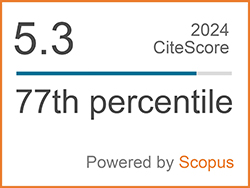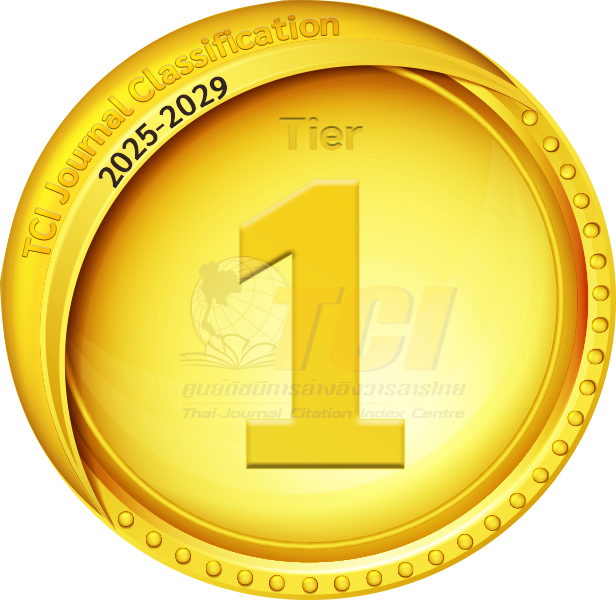Impact of Die Exit Temperature on the Crystalline Orientation and Performance of Polypropylene Battery Separators
Abstract
Keywords
[1] C. Shunhong, S. Pullteap, and T. Mao, “Research progress and future expectations in anode of secondary zinc-air batteries: A review,” Applied Science and Engineering Progress, vol. 17, no. 3, Jul. 2024, Art no. 7410, doi: 10.14416/j.asep. 2024.06.006.
[2] M. Lowe, S. Tokuoka, T. Trigg, and G. Gereffi, “Lithium-ion batteries for electric vehicles: the U.S. value chain,” Duke University CGGC: Durham, NC, USA, Oct. 2010, doi: 10.13140/ RG.2.1.1421.0324.
[3] S. Mahmud et al., “Recent advances in lithium-ion battery materials for improved electrochemical performance: A review,” Results in Engineering, vol. 15, Sep. 2022, Art no. 100472, doi: 10.1016/j.rineng.2022.100472.
[4] N. Lingappan, W. Lee, S. Passerini, and M. Pecht, “A comprehensive review of separator membranes in lithium-ion batteries,” Renewable and Sustainable Energy Reviews, vol. 187, Nov. 2023, Art. no. 113726, doi: 10.1016/j.rser.2023. 113726.
[5] P. Arora and Z. Zhang, “Battery separators,” Chemical Reviews, vol. 104, no. 10, pp. 4419–4462, Oct. 2004, doi: 10.1021/cr020738u.
[6] S. S. Zhang, “A review on the separators of liquid electrolyte Li-ion batteries,” Journal of Power Sources, vol. 164, no. 1, pp. 351–364, Jan. 2007, doi: 10.1016/j.jpowsour.2006.10.065.
[7] M. Yang and J. Hou, “Membranes in lithium ion batteries,” Membranes, vol. 2, no. 3, pp. 367–383, Jul. 2012, doi: 10.3390/membranes2030367.
[8] C. Lei, Q. Cai, R. Xu, X. Chen, and J. Xie, “Influence of magnesium sulfate whiskers on the structure and properties of melt-stretching polypropylene microporous membranes,” Journal of Applied Polymer Science, vol. 133, no. 35, Sep. 2016, Art no. 43884, doi: 10.1002/app.43884.
[9] Y. Lin et al., “A semi-quantitative deformation model for pore formation in isotactic polypropylene microporous membrane,” Polymer, vol. 80, pp. 214–227, Dec. 2015, doi: 10.1016/j.polymer.2015.10.067.
[10] S. H. Tabatabaei, P. J. Carreau, and A. Ajji, “Effect of processing on the crystalline orientation, morphology, and mechanical properties of polypropylene cast films and microporous membrane formation,” Polymer, vol. 50, no. 17, pp. 4228–4240, Aug. 2009, doi: 10.1016/j.polymer.2009.06.071.
[11] R. Xu, X. Chen, J. Xie, Q. Cai, and C. Lei, “Influence of melt-draw ratio on the crystalline structure and properties of polypropylene cast film and stretched microporous membrane,” Industrial & Engineering Chemistry Research, vol. 54, no. 11, pp. 2991–2999, Mar. 2015, doi: 10.1021/acs.iecr.5b00215.
[12] L. Ding, R. Xu, L. Pu, F. Yang, T. Wu, and M. Xiang, “Pore formation and evolution mechanism during biaxial stretching of β-iPP used for lithium-ion batteries separator,” Materials and Design, vol. 179, Oct. 2019, Art no. 107880, doi: 10.1016/j.matdes.2019.107880.
[13] Y. Ren, H. Zou, S. Wang, J. Liu, D. Gao, C. Wu, and S. Zhang, “Effect of annealing on microstructure and tensile properties of polypropylene cast film,” Colloid and Polymer Science, vol. 296, no. 1, pp. 41–51, Jan. 2018, doi: 10.1007/s00396-017-4220-8.
[14] J. Cui, J. Liu, C. He, J. Li, and X. Wu, “Composite of polyvinylidene fluoride–cellulose acetate with Al(OH)₃ as a separator for high-performance lithium ion battery,” Journal of Membrane Science, vol. 541, pp. 661–667, Nov. 2017, doi: 10.1016/j.memsci.2017.07.048.
[15] V. Deimede and C. Elmasides, “Separators for lithium‐ion batteries: A review on the production processes and recent developments,” Energy Technology, vol. 3, no. 5, pp. 453–468, May. 2015, doi: 10.1002/ente.201402215.
[16] Y. Li, H. Pu, and Y. Wei, “Polypropylene/ polyethylene multilayer separators with enhanced thermal stability for lithium-ion battery via multilayer coextrusion,” Electrochimica Acta, vol. 264, pp. 140–149, Feb. 2018, doi: 10.1016/ j.electacta.2018.01.114.
[17] H. Lee, M. Yanilmaz, O. Toprakci, K. Fu, and X. Zhang, “A review of recent developments in membrane separators for rechargeable lithium-ion batteries,” Energy & Environmental Science, vol. 7, no. 12, pp. 3857–3886, Dec. 2014, doi: 10.1039/c4ee01432d.
[18] C. Li and R. Xu, “Melt-stretching polyolefin microporous membrane,” in Submicron Porous Materials, P. Bettotti, Ed. Cham: Springer, 2017, pp. 81–105. doi: 10.1007/978-3-319-53035-2_4.
[19] R. Xu, S. Zeng, J. Wang, J. Kang, M. Xiang, and F. Yang, “Impact of different die draw ratio on crystalline and oriented properties of polypropylene cast films and annealed films,” Journal of Polymer Research, vol. 25, May. 2018, Art. no. 142 doi: 10.1007/s10965-018-1534-2.
[20] R. J. Xu et al., “Micropore formation process during stretching of polypropylene casting precursor film,” Plastics, Rubber and Composites, vol. 43, no. 8, pp. 257–263, Oct. 2014, doi: 10.1179/1743289814y.0000000100.
[21] M. Farah and R. E. S. Bretas, “Characterization of i‐PP shear‐induced crystallization layers developed in a slit die,” Journal of Applied Polymer Science, vol. 91, no. 6, pp. 3528–3541, Mar. 2004, doi: 10.1002/app.13576.
[22] W. H. Bednarek, D. Paukszta, M. Szostak, and J. Szymańska, “Fundamental studies on shear-induced nucleation and beta-phase formation in the isotactic polypropylene-effect of the temperature,” Journal of Polymer Research, vol. 28, Oct. 2021, Art. no. 439, doi: 10.1007/s10965-021-02652-5.
[23] S. Zhang et al., “Nanocomposite polymer membrane derived from nano TiO2-PMMA and glass fiber nonwoven: High thermal endurance and cyclestability in lithium ion battery applications,” Journal of Materials Chemistry A, vol. 3, no. 34, pp. 17697–17703, Sep. 2015, doi: 10.1039/C5TA02781K.
[24] H. Kim, V. Guccini, H. Lu, G. Salazar-Alvarez, G. Lindbergh, and A. Cornell, “Lithium ion battery separators based on carboxylated cellulose nanofibers from wood,” ACS Applied Energy Materials, vol. 2, no. 2, pp. 1241–1250, Feb. 2019, doi: 10.1021/acsaem.8b01797.
[25] A. Manthiram, “A reflection on lithium-ion battery cathode chemistry,” Nature Communications, vol. 11, no. 1, Mar. 2020, Art no. 1550, doi: 10.1038/s41467-020-15355-0.DOI: 10.14416/j.asep.2025.10.002
Refbacks
- There are currently no refbacks.
 Applied Science and Engineering Progress
Applied Science and Engineering Progress







